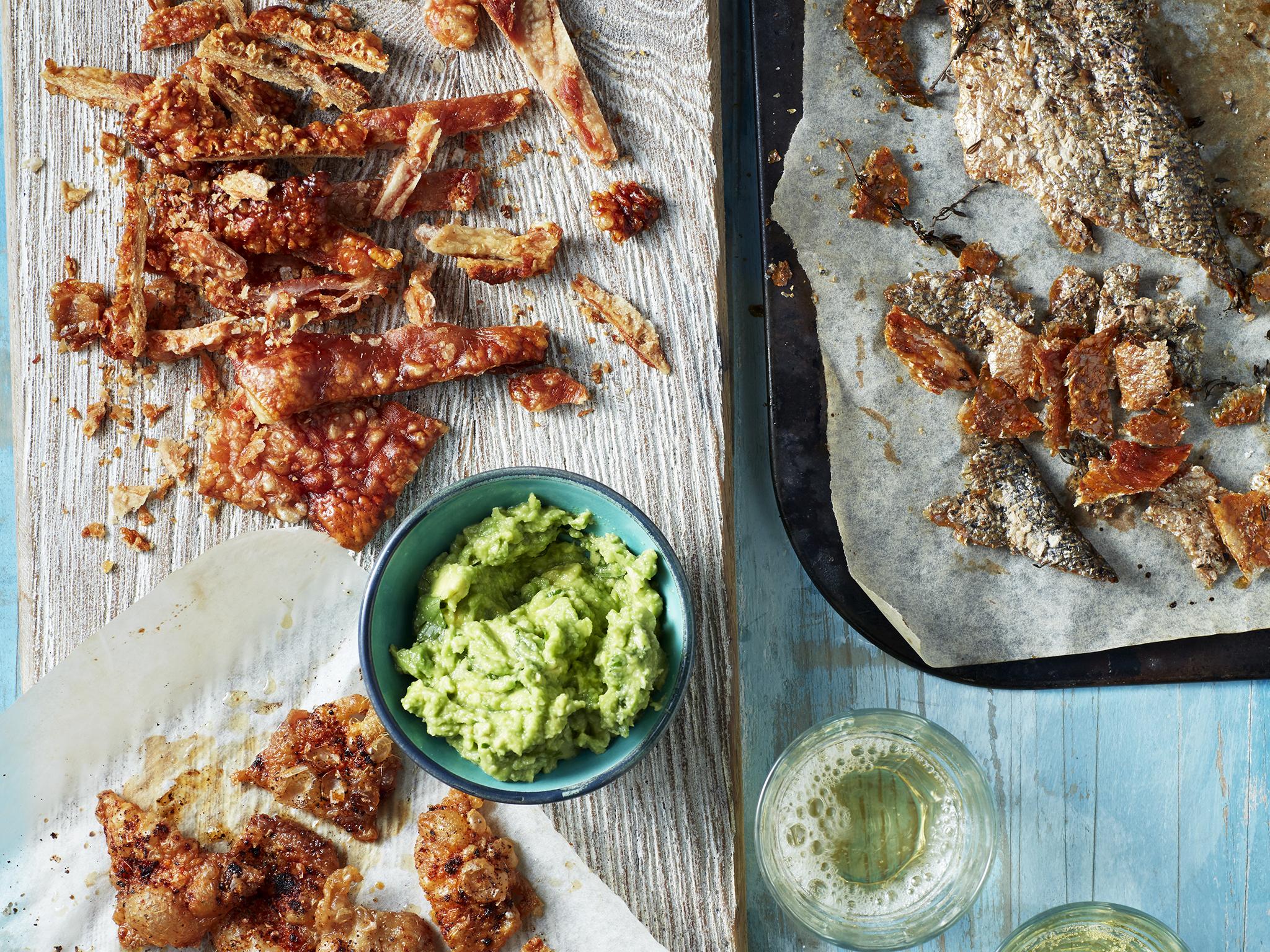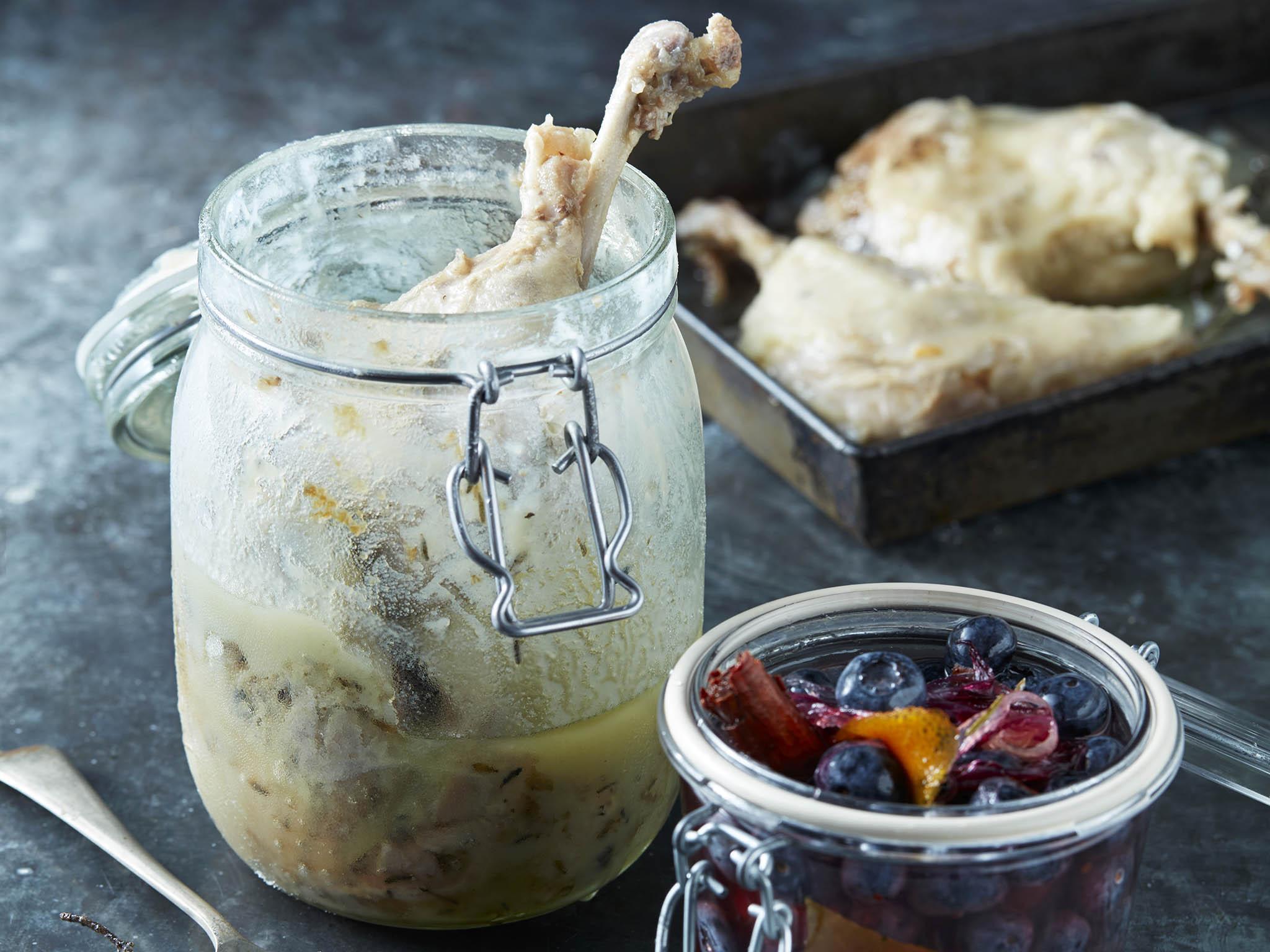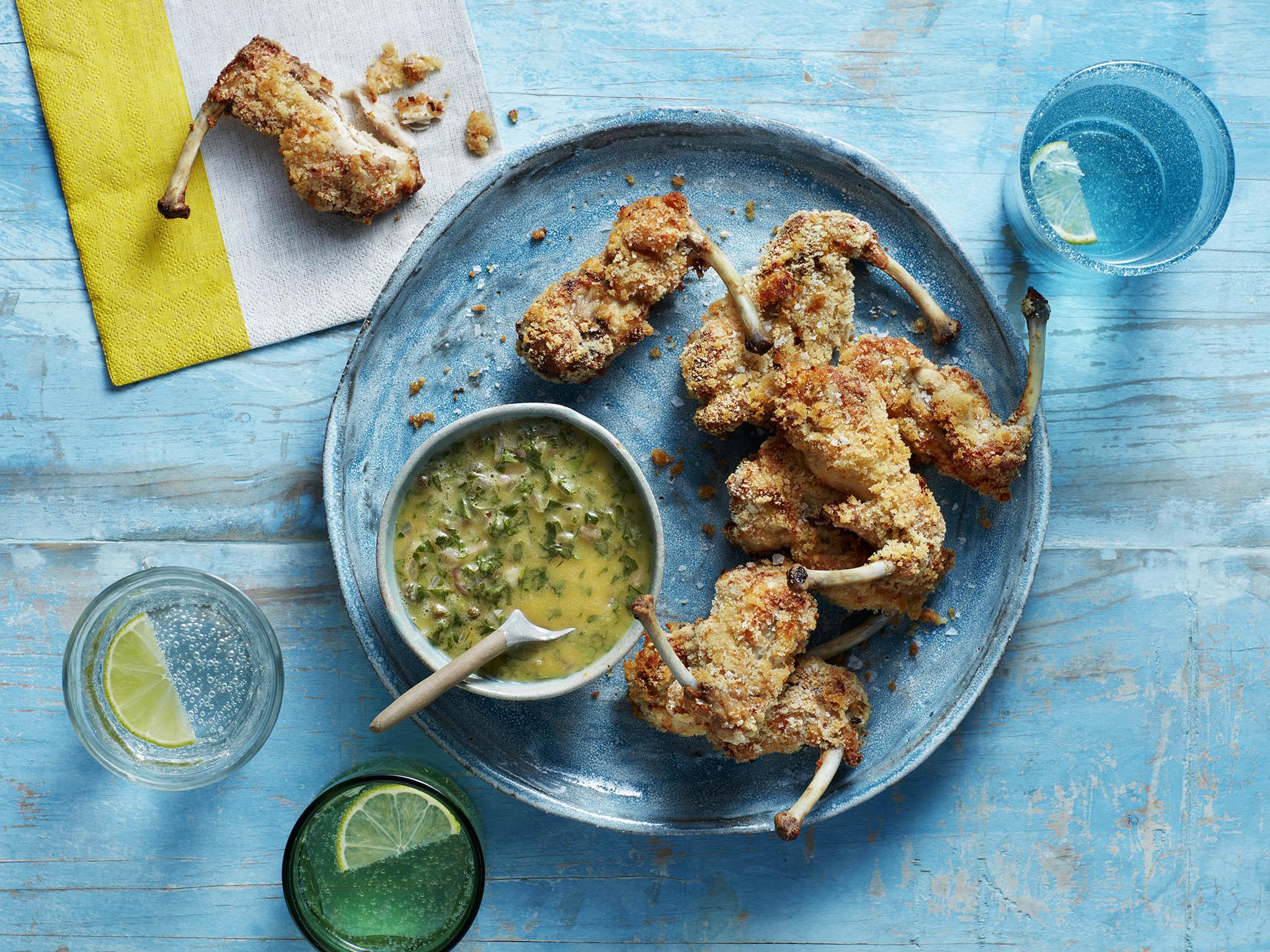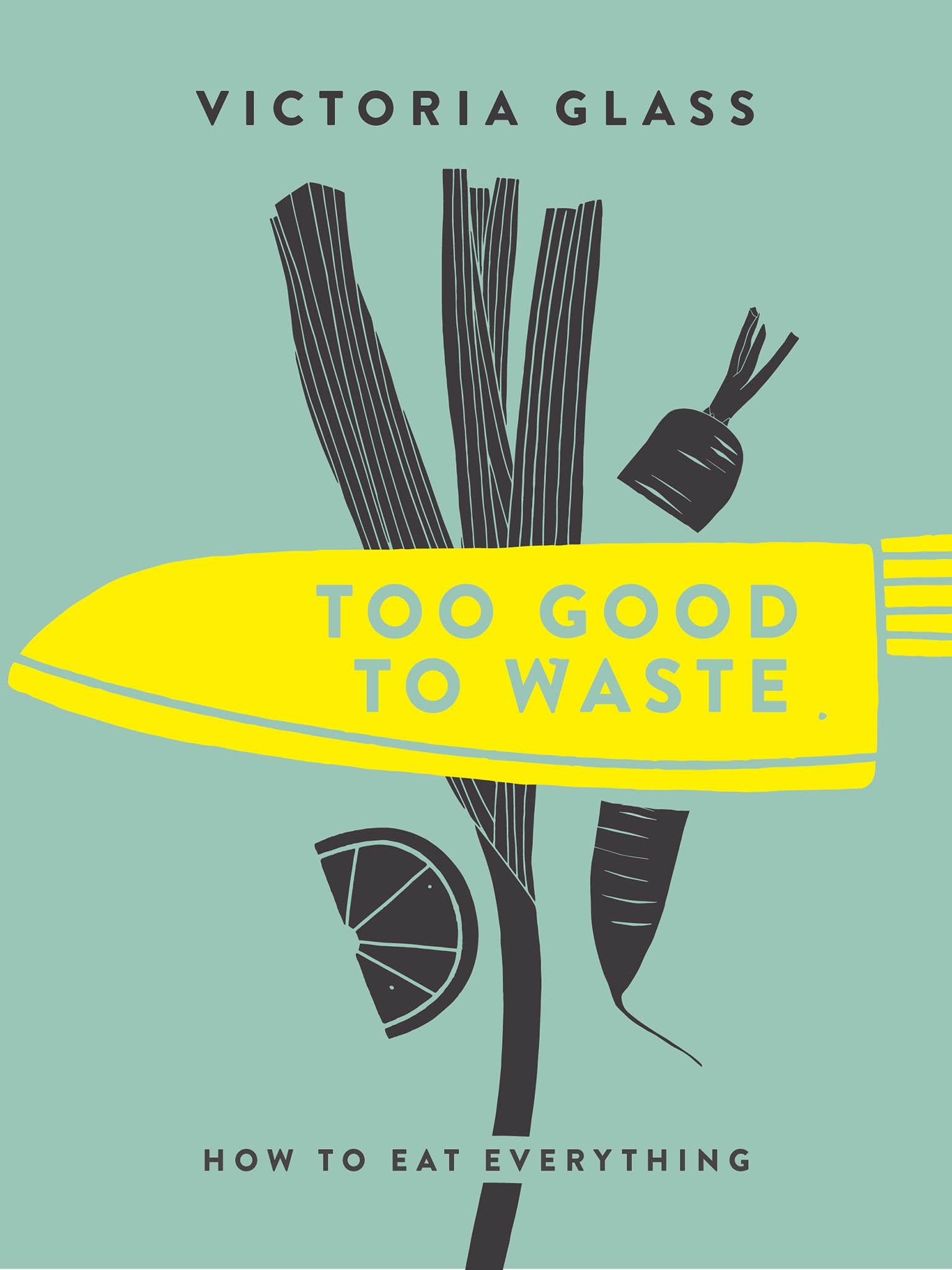‘Too Good to Waste’ recipes: A new lease of life for your chicken carcass
Ever feel guilty when throwing out perfectly useable trimmings? Now there is no excuse

Chicken crackling
Salty, crunchy and full of flavour, you’ll never throw your chicken skin in the trash again after tasting this.
Chicken skin, cut into 7.5cm pieces
Sea salt flakes
Freshly ground black pepper
Any herbs or spices of your choosing, such as paprika, thyme, chopped rosemary or ground cumin (optional)
Heat the oven to 200C / gas mark 6 and line a baking sheet with baking parchment. Pat the chicken skin dry with paper towels and spread out on the prepared baking sheet, skin-side up. Sprinkle generously with salt and pepper, plus any herbs or spices, if using. Cover the chicken skin with another sheet of baking parchment and place another baking sheet on top to weigh the skin down. Bake for 25-30 minutes, or until golden and crisp.
Remove the top baking sheet and parchment. The crackling can be eaten hot or, once cool, you can break it into shards to serve. It is delicious served as canapes with drinks or you can use it to add texture to poultry dishes, salads or crumbles.

Meat confit
Cooking meat in its own fat yields irresistibly succulent results. Once cold, the fat forms a barrier to bacterial growth, ensuring the meat can be preserved for several months.
Serves 4
45g / ¼ cup fine sea salt
6 sprigs of thyme, leaves picked (stalks saved for stock)
1 tsp juniper berries
3 garlic cloves
3 strips of orange or lemon zest, chopped
1 tsp black peppercorns
about 1kg game bird or poultry legs (such as 4 plump duck legs, or 2 goose legs) or boned pork belly or shoulder
1-1.5 litres rendered fat (duck or goose fat are my preferred choices, but you can use lard or even olive oil, if you prefer)
Place the salt and aromatics in a pestle and mortar and grind to a dry paste. Put the meat in a dish large enough to fit it in a single layer. Rub the salt mixture into the meat, cover the dish with cling film/plastic wrap and leave to cure in the refrigerator for 24-36 hours.
Heat the oven to 130C / gas 1. Rub off as much of the salt mixture as possible using paper towels. Rinse the meat under cold water to remove the rest. Pat thoroughly dry with paper towels. Put the meat in an ovenproof dish large enough to fit it snugly in a single layer. Pour over the rendered fat so that all the meat is fully submerged. If the fat has set, gently melt it over a very low heat.
Cover the dish with baking parchment and kitchen foil and cook in the oven for about 3 hours, or until the meat is tender. It should come away from the bone easily but not fall off unprompted: the juices should run clear.
Carefully lift the meat out of the fat and place it in a large sterilised Kilner jar. Strain the fat through a sieve/fine-mesh strainer lined with muslin/cheesecloth into a jug, then allow to settle so the meat juices can separate from the fat. Carefully ladle the fat over the meat, seal and leave to cool completely. Once cold, you can store the confit meat, somewhere cool and dark for several weeks, or even months.
The meat juices will be left at the bottom of the jug. Once cold, they will turn into a thick jelly, which you can use to boost flavour in sauces or soups, or for fondant potatoes.
Confit birds can be oven roasted in a hot oven (200°C / gas mark 6) for about 30 minutes (less for smaller birds, or if using wings) to crisp up. They are delicious served with puy lentils or sautéed potatoes, cooked in cassoulet, or simply shredded and strewn in a salad. Confit pork can be roasted in the same way, or you can shred it and mix it with some of the warm confit cooking fat to make rillettes. Serve with crusty bread and cornichons as a delicious starter.

Chicken wings with lemon and caper sauce
I like to take out one of the central wing bones and leave the other to use as a sort of skewer to hold them with. You can leave them in to avoid any butchery, or if you enjoy gnawing round a bone.
Serves 4
16 chicken wings
2 tbsp plain flour
2 eggs, beaten
50g breadcrumbs made from day-old bread
50g unsalted butter
1 small onion, finely chopped
Juice of 1 large lemon
2 tbsp capers, rinsed
1 small bunch of flatleaf parsley, roughly chopped
1 egg yolk
Fine sea salt and freshly ground black pepper
Hold the thin tip of a chicken wing (you may grip better if you use a clean dish towel but please remember to launder it immediately). Hold the fat end of the wing firmly with your other hand and break the wing at the joint. You will see two bones under the skin. Put your thumb behind the bones and pull forwards. The bones should pop through the skin fairly easily, but if they don’t, make a small incision with a paring knife. Slice off the end of the chicken wing tip and save for stock.
Firmly pull out one of the two chicken bones (again, you may need the towel for grip). You should not need to cut the bone out. You should be left with one bone protruding from the flesh of the wing. Remove any excess skin with a sharp knife . Repeat with the remaining wings. Heat the oven to 180°C and line a baking sheet with baking parchment.
Season the flour with salt and put in a shallow bowl. Put the eggs in a second bowl and the breadcrumbs and a little salt and pepper in a third. Dunk a chicken wing first in the flour and tap off the excess, then dunk in the egg and finally in the breadcrumbs. Repeat this to double-coat the wing, if you wish. Repeat with the remaining wings. Place the chicken wings on the prepared baking sheet. Roast for 20-25 minutes, or until golden and cooked through.
Meanwhile melt the butter in a small pan and gently sautée the onion for 10 minutes, or until soft and pale golden. Season generously with black pepper and cook for 1 minute, stirring.
Whisk in the lemon juice until amalgamated, add the capers and cook for a few minutes. Taste before seasoning with salt, as the capers can be quite salty. Remove the pan from the heat and stir in the parsley. Leave to cool slightly before whisking in the egg yolk to thicken the sauce. Serve immediately with the hot chicken wings.
Chicken carcass curry
Serves 4
Cooking the whole carcass in the pan imparts so much flavour, that even if there isn’t an enormous amount of meat left, you will still feel sated. You can pad out the leftover meat with chickpeas if you’ve really picked the carcass clean.
3 onions, sliced into half moons
2-3 tbsp sunflower oil
1 roast chicken carcass
6 garlic cloves, crushed
2 peppers, any colour, deseeded and diced
1-2 long red chillies, deseeded if you don’t like too much heat, and finely chopped or: 1-2 tsp dried chilli / hot pepper flakes, a thumb of root ginger, peeled and finely chopped
2 tsp cumin seeds
2 tsp ground cumin
2 tsp ground coriander
1 tsp ground turmeric
1 tsp fine sea salt
400g can chopped tomatoes in natural
tomato juice
400g can of chickpeas (optional)
250g spinach leaves
Juice of ½ a lemon
1 bunch of coriander/cilantro, chopped
Freshly ground black pepper
In a large saucepan, toss the onions in the oil, then place over a medium heat. Stir every now and then until the onions become a deep brown colour – be careful not to burn them. It is important that you let the onions become quite dark at this stage as this adds depth of flavour.
Meanwhile, pick all the remaining meat off the chicken. Cut the carcass in half lengthways. Add the garlic, peppers, chillies and ginger to the onions, reduce the heat and continue to stir until the peppers have softened. You can add a splash of water to stop the vegetables from catching, but only if you need to.

Once the vegetables are soft, add the spices and salt and cook through for about a minute, stirring all the time. Add the picked chicken meat and stir into the spices to coat. Stir in the tomatoes and rest the carcass halves on top. Swish round the tomato cans with water and add about one litre to the pan so that the chicken bones are just barely covered. Leave to simmer, over a low heat, uncovered, for 1-1½ hours. This will be enough time for the bones to impart a good flavour.
Remove the chicken carcass and discard. Add the chickpeas, if using, turn up the heat and simmer for 45 minutes, stirring intermittently, or until the liquid has reduced by half.
Add the spinach, squeeze the lemon juice over the top and simmer for about 20 minutes, or until the curry is thick and aromatic. Adjust the seasoning, if necessary. Stir through the fresh coriander just before serving.
Recipes extracted from ‘Too Good To Waste’ by Victoria Glass © Victoria Glass 2017, published by Nourish Books, £14.99
Join our commenting forum
Join thought-provoking conversations, follow other Independent readers and see their replies
Comments